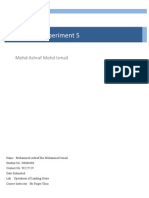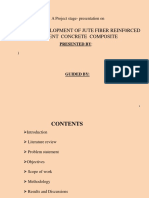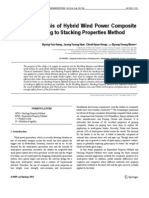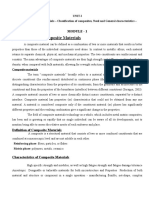Professional Documents
Culture Documents
Mechanical Properties of GFR & Graphite Epoxy Polymer Composites
Copyright
Available Formats
Share this document
Did you find this document useful?
Is this content inappropriate?
Report this DocumentCopyright:
Available Formats
Mechanical Properties of GFR & Graphite Epoxy Polymer Composites
Copyright:
Available Formats
Volume 5, Issue 6, June – 2020 International Journal of Innovative Science and Research Technology
ISSN No:-2456-2165
Mechanical Properties of GFR & Graphite
Epoxy Polymer Composites
A.Aakash 1, S.Selvaraj 2
1
PG Scholar Department of Mechanical Engg., ACGCET, Karaikudi– 630003,
Tamil Nadu, INDIA.
2
ASSISTANT PROFESSOR Department of Mechanical Engg., ACGCET, Karaikudi -630003,
Tamil Nadu, INDIA.
Abstract:- Composite materials have the great potential fiber content decreases ductile content of the material.
and widely used as building material in numerous Elanchezhian C [2] conducted a work on varying strain
applications. Polymer composite material obtains the rates and temperatures on the materials of glass and carbon
necessary properties in a controlled significant degree fiber reinforced polymer composites in order to analyse the
by the selection of strands and lattice. The properties of mechanical behaviour of the composite material. Here the
the materials have been selected by choosing the correct force versus displacement and time versus force curves for
proportion of matrix and reinforcements. To build the each case have been drawn. The impact strength has the
quality of the material by expanding the fiber substance significant effect on the material as the material strength
of the material. In this current examination, the has decreased due to less amount of fiber content on the
mechanical properties of the glass fiber and graphite is particular composite material. Hence increasing the fiber
strengthened with epoxy polymer composite were content will increases the strength of the material. Jacob
considered. Here the open embellishment method was Olaitan Akindapo [3] evaluated the mechanical properties
received for the manufacture of the polymer composite of coconut shell fibers as reinforcement material and epoxy
The mechanical properties, for example, rigidity, resin as the matrix material and fabricated the composite
compression quality, sway quality and water ingestion material using compression moulding technique.
test was resolved according to the ASTM norms. The Mechanical properties, for example, rigidity, pressure
mechanical properties were improved as the filaments quality, flexural quality, and effect quality are assessed.
support content expanded in the grid material. The interfacial properties, inward splits, and inner structure
of the cracked surfaces are assessed by utilizing SEM. The
Keywords:- Glass Fiber, Graphite, Epoxy Resin, Hand last explanation showed that the joining of coconut shell
Lay-Up Technique. filaments with epoxy pitch can improve the properties of
the composite material. T.D. Jagannatha [4] experiment on
I. INTRODUCTION the mechanical properties of carbon/glass fiber
strengthened epoxy half breed polymer composites. At first
This paper shows that the mixing of manufactured the materials contain the carbon fiber and glass filaments
filaments in half and half composites has progressively are fortifications and epoxy half and half tar are utilized as
applied in a few unique fields of building and innovation. lattice. The mechanical properties, for example, elasticity
In automobile industries, steels are also used in car and hardness are assessed. The small-scale hardness of
bumpers. In this present work, steel is replaced with carbon fiber fortified composite is higher than different
composite material. Composites are overwhelming the composites. The malleability of carbon fiber strengthened
business. The quality of the composites relies upon the composite is higher than different composites. Akar Dogan
attributes of the support and the network stages. Further [5] variety of the mechanical properties of E-glass/epoxy
expansion of particles (Hardener) into the grid improves the composites is exposed to aqueous maturing. The vacuum-
general properties and attributes of the composite material. helped tar implements forming was utilized to make
The flow inquire about includes the manufacture of the composites. In assembling of composites, unidirectional E-
glass fiber strengthened, graphite composites with epoxy glass textures with areal thickness of 300g/m2 and a pitch
gum particles in the lattice utilizing hand lay-up process. A framework (Araldite LY 564/Aradur 3487 BD) were
composite material (likewise called a synthesis material or utilized. To decide the mechanical properties, for example,
abbreviated to composite, which is the basic name) is a modulus of versatility, longitudinal, and transverse quality,
material produced using at least two constituent materials shear quality and Poisson's proportion of the composite
with fundamentally unique physical or compound materials are directed. The ingested vitality increment for
properties that, when joined, produce a material with 100h matured examples and the assimilated vitality
qualities not the same as the individual segments. K.Naresh generally stays steady until 800h and afterward diminishes.
Kumar [1] investigated the mechanical properties of the Most extreme contact power and deflection are of
glass fiber polymer matrix with reinforcement of coal ash. comparable conduct.
In this composite material is to increase and enhance the
elastic modulus and tensile strength with increasing the
glass fiber content. However, the rupture behaviour
changes from ductile to brittle. However increasing the
IJISRT20JUN277 www.ijisrt.com 560
Volume 5, Issue 6, June – 2020 International Journal of Innovative Science and Research Technology
ISSN No:-2456-2165
II. METHODOLOGY III. SPECIMEN PREPARATION
The glass fiber, graphite and epoxy are the selected The glass fiber and graphite fiber
materials as per the above studies. To create the composite strengthened epoxy composite pieces were taken
material hand-lay-up strategy is reasonable for the chosen out from the form and afterward the examples
type pitch superior to other embellishment method To were cut into appropriate measurements
avoid resin air gap caused during the curing process can according to the ASTM standards according to
cause low bonding between the resin and reinforcement different mechanical testing. Using the different
materials. tools in the workshop the test specimen was cut
from the composite slabs. Here ASTM standard
Fabrication of composites: a370 is used for mechanical testing for tensile,
Mould made of mild steel was used with dimensions compression and impact testing of the composite
of 300x300x10mm of each specimen for tensile test this material.
method is the cheapest method of manufacturing the quality
of the composite depends on the skills. Gel coat is first IV. TESTING OF THE COMPOSITE
applied to the form utilizing a splash firearm for a top- MATERIALS
notch surface. At the point when the gel coat has relieved
move stock glass fiber fortification is physically positioned The mechanical properties of the composite
on the shape were assessed by tractable, pressure, effect, and
water assimilation estimations. The examples are
set up from the manufactured composites and the
edges are done by utilizing record and Emery
sheet. Pliable testing was inspected by ASTM
a370. The examples were stacked between two
physically movable grippers of 60KN on the
mechanized all-inclusive testing machine with an
electronic extensometer which is used for
measuring the elongation of the gauge length.
The load is applied until the material gets
fractured. Here the elongation, maximum load,
initial and final gauge length of the specimen is
recorded. The test was rehashed for another
example and the normal was taken from the
elasticity of the composite material. Compression
Fig 1:- Mould plate testing was examined same as ASTM a370. The
specimens were loaded between the plates of the
universal testing machine. Here the material
experiences the opposing forces that the forces
which acts inwards through the specimen. Impact
testing was examined according to ASTM a370.
Here izod testing machine is used for impact test.
The center of the specimen was cut into V-notch
and the position of the specimen is placed
vertically. Direction of the notch face is placed in
front of the striker. The striking point of the
specimen is the upper tip. This is also called as
pendulum testing machine. Water absorption
testing shows that the material capability to
withstand amount of water can absorb with in the
Fig 2:- Composite plates period of time under specific conditions. The
standard used for water adsorption is ASTM
The covering gum is applied by pouring, brushing, D570. The equipment used to measure the weight
splashing, or utilizing a paint roller. FRP rollers, paint is mettler balance. The specimen is dried in a
rollers are utilized to unite the cover, wetting the support broiler for a predetermined time and temperature
and expelling ensnared air. Then the second layer of the and the set in a desiccator for cooling the
graphite reinforcement is mixed with resin and is poured example. The examples are weighed before
above the previous layer. Then another layer of glass fiber testing. At that point the material is risen in water
reinforcement is added to build laminate thickness. Then at covetousness upon conditions for 48hrs and
the material is then placed in the open atmosphere for the 96hrs. At that point the examples are evacuated
curing process. Two identical specimens were preparing at tapped dry with a buildup free material and
various compositions. gauged.
IJISRT20JUN277 www.ijisrt.com 561
Volume 5, Issue 6, June – 2020 International Journal of Innovative Science and Research Technology
ISSN No:-2456-2165
V. RESULT AND DISCUSSION
A. Tensile strength:
Fig 3:- tensile specimen dimensions
The pliable test was performed distinctly on the level composite example. The components of the
example according to the ASTM standard are appeared in the above figure. The test was performed for four
samples and the average value is taken for analysis.
Table 1:- tensile strength tabulation
In this analysis the second specimen has the high tensile strength than the first specimen due to the
variation of reinforcement such as increasing the graphite powder and decreasing the glass fiber content so
that the second specimen can withstand load than the first specimen. This shows that the increasing the
reinforcement will increasing the strength of the material.
Total load Vs Tensile strength
45
40 41.88
37.57
Tensile Strength
35
30.62 35.15
30
25
20
15
10
5
0
6.57 6.95 8.24 9.24
Total Load
Fig 4
IJISRT20JUN277 www.ijisrt.com 562
Volume 5, Issue 6, June – 2020 International Journal of Innovative Science and Research Technology
ISSN No:-2456-2165
Fig 5:- Tensile Specimen-1
Fig 6:- Tensile Specimen-2
IJISRT20JUN277 www.ijisrt.com 563
Volume 5, Issue 6, June – 2020 International Journal of Innovative Science and Research Technology
ISSN No:-2456-2165
B. Impact strength: D. Water retention:
Water retention test is utilized to decide the measure
of water ingested under the particular conditions. The factor
that affects the water absorption is the type of plastics used,
additives added, temperature available, and the length of
the exposure. The ASTM standard used for water
absorption is D570. The specimen is then dried on the oven
and weighted in the mettler balance then immersed in the
liquid placed at the room temperature for 48hrs and 96hrs.
Then the specimen is weighted at 48hrs and 96hrs. Then
Fig 7:- impact specimen dimensions compare before water absorption weight and after water
absorption weight and the results are noted in the tabular
Effect test was proceeded according to the column.
ASTM standard appeared over the figure. In this
impact test the specimen is V-notched at the
center of the specimen in one side and the other
side is left as plain surface. The specimen is
placed on the izod testing machine, notch face is
placed in front of the striker. The striker is lifted
at an angle of 45 and then the striker is locked up.
When the lock is released the striker hits the Table 4:- water retention tabulation
upper part of the specimen. Then the impact
values re measured in joules and noted down.
Table 2:- impact strength tabulation
From the above analysis the second specimen requires
more joules to break the specimen than the first specimen.
So that mixing ratio of the second specimen gives more
strength then the first specimen ratio.
C. Compressive strength:
Fig 9:- specimen 1
Fig 8:- compression specimen dimensions
A pressure test is any test wherein a material
encounters contradicting powers that push internal upon the
example from inverse sides or is in any case compacted,
crushed, squashed, or straightened. Reason for pressure
tests is to decide the conduct or reaction of a material while
it encounters a compressive burden by estimating central
factors, for example, strain, stress, and disfigurement. The
ASTM for compression test is a370.
Table 3:- compressive strength tabulation
From the above analysis the second specimen gives
the high compressive strength than the first specimen. So
that the second specimen mixing ratio is better than the first Fig 10:- specimen 2
specimen.
IJISRT20JUN277 www.ijisrt.com 564
Volume 5, Issue 6, June – 2020 International Journal of Innovative Science and Research Technology
ISSN No:-2456-2165
VI. CONCLUSION [9]. Akula Swathi, S.Bhanu Murthy, K.Nagendra Babu
(2019) "Evaluation of Mechanical Properties of GFRP
Fiber strengthened composite are one of the blasting Composites with Fillers", IJITEE Vol. 8 Issue11
materials in aviation, car, marine, development, and [10]. Sutrisno, Sutomo, Sudarno, and T.Tristono
building Enterprises. In which Glass strands are playing a (2019)"Study on Mechanical Properties of Composite
fundamental job in fiber fortified composite as a result of Geomaterial Powder Waste Tiles and Glass Fiber",
its great mechanical properties. In this part the ends are AIMS Materials Science vol.6
made by the outcome got by examination of glass
fiber/graphite fortified polymer composite. Examinations
are done by ductile, pressure, effect, and water assimilation
testing. The following conclusions can be drawn from the
present investigation.
The second mixing ratio of glass fiber (20%) +Epoxy
resin+ graphite (4%) Shows higher tensile, compressive
strength, maximum impact strength and high water
absorption rate from these investigations. Due to higher
volume of reinforcements in the specimen induces the
mechanical properties.
REFERENCES
[1]. K.Naresh Kumar, M.Prasanth kumar, V. Krishna,
D.Srinivasa Rao (2013), "Experimental Investigation
on Mechanical Properties of Coal Ash Reinforced
Glass Fiber Polymer Matrix Composites", IJETAE,
ISSN 2250-2459.
[2]. Elanchezhian C, Ramnath BV, Hemalatha J (2014)
"Mechanical behaviour of glass and carbon fiber
reinforced composites at varying strain rates and
temperatures", Procedia Materials Science vol. 6, No.
1405-18.
[3]. Jacob Olaitan Akindapo, Ayogu Harrison, Olawale
Monsur Sanusi (2014) “Evaluation of Mechanical
Properties of Coconut Shell Fibers as Reinforcement
Material in Epoxy Matrix”, IJERR, Vol. 3 ISSN 2337-
2348.
[4]. T.D.Jagannatha and G Harish (2015) "Mechanical
Properties Of Carbon/Glass Fiber Reinforced Epoxy
Hybrid Polymer Composites", IJMERR Vol. 4, No. 2
[5]. Akar Dogan, and Cesim Atas (2016) "Variation of the
mechanical properties of E-glass/epoxy composites
subjected to hydrothermal aging", Journal of
composite materials, Vol. 7 no. 637-646
[6]. Ramesh Kumar, Kishore Kumar Mahato, and Bankim
Chandra Ray (2016) "Water absorption behavior,
mechanical and thermal properties of nano TiO2
increased fiber bolstered compound composites",
Composites of a engineering science and production,
ISSN: 736-747.
[7]. Getahun Aklilu, Sarp Adali, Glen Bright (2017)
"Temperature effect on mechanical properties of
carbon, glass and hybrid polymer composite
specimens", IJERR Vol. 39, No. 119-125.
[8]. M. D. Kiran, H. K.Govindaraju , T. Jayaraju (2018)
"Evaluation of Mechanical Properties of Glass Fiber
Reinforced Epoxy Polymer Composites with
Alumina, Titanium dioxide and Silicon Carbide
Fillers", ELSEVIER ISSN:22355–22361
IJISRT20JUN277 www.ijisrt.com 565
You might also like
- Formulation and Evaluation of Poly Herbal Body ScrubDocument6 pagesFormulation and Evaluation of Poly Herbal Body ScrubInternational Journal of Innovative Science and Research TechnologyNo ratings yet
- Comparatively Design and Analyze Elevated Rectangular Water Reservoir with and without Bracing for Different Stagging HeightDocument4 pagesComparatively Design and Analyze Elevated Rectangular Water Reservoir with and without Bracing for Different Stagging HeightInternational Journal of Innovative Science and Research TechnologyNo ratings yet
- Explorning the Role of Machine Learning in Enhancing Cloud SecurityDocument5 pagesExplorning the Role of Machine Learning in Enhancing Cloud SecurityInternational Journal of Innovative Science and Research TechnologyNo ratings yet
- A Review: Pink Eye Outbreak in IndiaDocument3 pagesA Review: Pink Eye Outbreak in IndiaInternational Journal of Innovative Science and Research TechnologyNo ratings yet
- Design, Development and Evaluation of Methi-Shikakai Herbal ShampooDocument8 pagesDesign, Development and Evaluation of Methi-Shikakai Herbal ShampooInternational Journal of Innovative Science and Research Technology100% (3)
- Studying the Situation and Proposing Some Basic Solutions to Improve Psychological Harmony Between Managerial Staff and Students of Medical Universities in Hanoi AreaDocument5 pagesStudying the Situation and Proposing Some Basic Solutions to Improve Psychological Harmony Between Managerial Staff and Students of Medical Universities in Hanoi AreaInternational Journal of Innovative Science and Research TechnologyNo ratings yet
- A Survey of the Plastic Waste used in Paving BlocksDocument4 pagesA Survey of the Plastic Waste used in Paving BlocksInternational Journal of Innovative Science and Research TechnologyNo ratings yet
- Electro-Optics Properties of Intact Cocoa Beans based on Near Infrared TechnologyDocument7 pagesElectro-Optics Properties of Intact Cocoa Beans based on Near Infrared TechnologyInternational Journal of Innovative Science and Research TechnologyNo ratings yet
- Auto Encoder Driven Hybrid Pipelines for Image Deblurring using NAFNETDocument6 pagesAuto Encoder Driven Hybrid Pipelines for Image Deblurring using NAFNETInternational Journal of Innovative Science and Research TechnologyNo ratings yet
- Cyberbullying: Legal and Ethical Implications, Challenges and Opportunities for Policy DevelopmentDocument7 pagesCyberbullying: Legal and Ethical Implications, Challenges and Opportunities for Policy DevelopmentInternational Journal of Innovative Science and Research TechnologyNo ratings yet
- Navigating Digitalization: AHP Insights for SMEs' Strategic TransformationDocument11 pagesNavigating Digitalization: AHP Insights for SMEs' Strategic TransformationInternational Journal of Innovative Science and Research TechnologyNo ratings yet
- Hepatic Portovenous Gas in a Young MaleDocument2 pagesHepatic Portovenous Gas in a Young MaleInternational Journal of Innovative Science and Research TechnologyNo ratings yet
- Review of Biomechanics in Footwear Design and Development: An Exploration of Key Concepts and InnovationsDocument5 pagesReview of Biomechanics in Footwear Design and Development: An Exploration of Key Concepts and InnovationsInternational Journal of Innovative Science and Research TechnologyNo ratings yet
- Automatic Power Factor ControllerDocument4 pagesAutomatic Power Factor ControllerInternational Journal of Innovative Science and Research TechnologyNo ratings yet
- Formation of New Technology in Automated Highway System in Peripheral HighwayDocument6 pagesFormation of New Technology in Automated Highway System in Peripheral HighwayInternational Journal of Innovative Science and Research TechnologyNo ratings yet
- Drug Dosage Control System Using Reinforcement LearningDocument8 pagesDrug Dosage Control System Using Reinforcement LearningInternational Journal of Innovative Science and Research TechnologyNo ratings yet
- The Effect of Time Variables as Predictors of Senior Secondary School Students' Mathematical Performance Department of Mathematics Education Freetown PolytechnicDocument7 pagesThe Effect of Time Variables as Predictors of Senior Secondary School Students' Mathematical Performance Department of Mathematics Education Freetown PolytechnicInternational Journal of Innovative Science and Research TechnologyNo ratings yet
- Mobile Distractions among Adolescents: Impact on Learning in the Aftermath of COVID-19 in IndiaDocument2 pagesMobile Distractions among Adolescents: Impact on Learning in the Aftermath of COVID-19 in IndiaInternational Journal of Innovative Science and Research TechnologyNo ratings yet
- Securing Document Exchange with Blockchain Technology: A New Paradigm for Information SharingDocument4 pagesSecuring Document Exchange with Blockchain Technology: A New Paradigm for Information SharingInternational Journal of Innovative Science and Research TechnologyNo ratings yet
- Perceived Impact of Active Pedagogy in Medical Students' Learning at the Faculty of Medicine and Pharmacy of CasablancaDocument5 pagesPerceived Impact of Active Pedagogy in Medical Students' Learning at the Faculty of Medicine and Pharmacy of CasablancaInternational Journal of Innovative Science and Research TechnologyNo ratings yet
- Intelligent Engines: Revolutionizing Manufacturing and Supply Chains with AIDocument14 pagesIntelligent Engines: Revolutionizing Manufacturing and Supply Chains with AIInternational Journal of Innovative Science and Research TechnologyNo ratings yet
- Enhancing the Strength of Concrete by Using Human Hairs as a FiberDocument3 pagesEnhancing the Strength of Concrete by Using Human Hairs as a FiberInternational Journal of Innovative Science and Research TechnologyNo ratings yet
- Exploring the Clinical Characteristics, Chromosomal Analysis, and Emotional and Social Considerations in Parents of Children with Down SyndromeDocument8 pagesExploring the Clinical Characteristics, Chromosomal Analysis, and Emotional and Social Considerations in Parents of Children with Down SyndromeInternational Journal of Innovative Science and Research TechnologyNo ratings yet
- Supply Chain 5.0: A Comprehensive Literature Review on Implications, Applications and ChallengesDocument11 pagesSupply Chain 5.0: A Comprehensive Literature Review on Implications, Applications and ChallengesInternational Journal of Innovative Science and Research TechnologyNo ratings yet
- Teachers' Perceptions about Distributed Leadership Practices in South Asia: A Case Study on Academic Activities in Government Colleges of BangladeshDocument7 pagesTeachers' Perceptions about Distributed Leadership Practices in South Asia: A Case Study on Academic Activities in Government Colleges of BangladeshInternational Journal of Innovative Science and Research TechnologyNo ratings yet
- Advancing Opthalmic Diagnostics: U-Net for Retinal Blood Vessel SegmentationDocument8 pagesAdvancing Opthalmic Diagnostics: U-Net for Retinal Blood Vessel SegmentationInternational Journal of Innovative Science and Research TechnologyNo ratings yet
- The Making of Self-Disposing Contactless Motion-Activated Trash Bin Using Ultrasonic SensorsDocument7 pagesThe Making of Self-Disposing Contactless Motion-Activated Trash Bin Using Ultrasonic SensorsInternational Journal of Innovative Science and Research TechnologyNo ratings yet
- Natural Peel-Off Mask Formulation and EvaluationDocument6 pagesNatural Peel-Off Mask Formulation and EvaluationInternational Journal of Innovative Science and Research TechnologyNo ratings yet
- Beyond Shelters: A Gendered Approach to Disaster Preparedness and Resilience in Urban CentersDocument6 pagesBeyond Shelters: A Gendered Approach to Disaster Preparedness and Resilience in Urban CentersInternational Journal of Innovative Science and Research TechnologyNo ratings yet
- Handling Disruptive Behaviors of Students in San Jose National High SchoolDocument5 pagesHandling Disruptive Behaviors of Students in San Jose National High SchoolInternational Journal of Innovative Science and Research TechnologyNo ratings yet
- The Subtle Art of Not Giving a F*ck: A Counterintuitive Approach to Living a Good LifeFrom EverandThe Subtle Art of Not Giving a F*ck: A Counterintuitive Approach to Living a Good LifeRating: 4 out of 5 stars4/5 (5794)
- The Little Book of Hygge: Danish Secrets to Happy LivingFrom EverandThe Little Book of Hygge: Danish Secrets to Happy LivingRating: 3.5 out of 5 stars3.5/5 (399)
- A Heartbreaking Work Of Staggering Genius: A Memoir Based on a True StoryFrom EverandA Heartbreaking Work Of Staggering Genius: A Memoir Based on a True StoryRating: 3.5 out of 5 stars3.5/5 (231)
- Hidden Figures: The American Dream and the Untold Story of the Black Women Mathematicians Who Helped Win the Space RaceFrom EverandHidden Figures: The American Dream and the Untold Story of the Black Women Mathematicians Who Helped Win the Space RaceRating: 4 out of 5 stars4/5 (894)
- The Yellow House: A Memoir (2019 National Book Award Winner)From EverandThe Yellow House: A Memoir (2019 National Book Award Winner)Rating: 4 out of 5 stars4/5 (98)
- Shoe Dog: A Memoir by the Creator of NikeFrom EverandShoe Dog: A Memoir by the Creator of NikeRating: 4.5 out of 5 stars4.5/5 (537)
- Elon Musk: Tesla, SpaceX, and the Quest for a Fantastic FutureFrom EverandElon Musk: Tesla, SpaceX, and the Quest for a Fantastic FutureRating: 4.5 out of 5 stars4.5/5 (474)
- Never Split the Difference: Negotiating As If Your Life Depended On ItFrom EverandNever Split the Difference: Negotiating As If Your Life Depended On ItRating: 4.5 out of 5 stars4.5/5 (838)
- Grit: The Power of Passion and PerseveranceFrom EverandGrit: The Power of Passion and PerseveranceRating: 4 out of 5 stars4/5 (587)
- Devil in the Grove: Thurgood Marshall, the Groveland Boys, and the Dawn of a New AmericaFrom EverandDevil in the Grove: Thurgood Marshall, the Groveland Boys, and the Dawn of a New AmericaRating: 4.5 out of 5 stars4.5/5 (265)
- The Emperor of All Maladies: A Biography of CancerFrom EverandThe Emperor of All Maladies: A Biography of CancerRating: 4.5 out of 5 stars4.5/5 (271)
- On Fire: The (Burning) Case for a Green New DealFrom EverandOn Fire: The (Burning) Case for a Green New DealRating: 4 out of 5 stars4/5 (73)
- The Hard Thing About Hard Things: Building a Business When There Are No Easy AnswersFrom EverandThe Hard Thing About Hard Things: Building a Business When There Are No Easy AnswersRating: 4.5 out of 5 stars4.5/5 (344)
- Team of Rivals: The Political Genius of Abraham LincolnFrom EverandTeam of Rivals: The Political Genius of Abraham LincolnRating: 4.5 out of 5 stars4.5/5 (234)
- The Unwinding: An Inner History of the New AmericaFrom EverandThe Unwinding: An Inner History of the New AmericaRating: 4 out of 5 stars4/5 (45)
- The World Is Flat 3.0: A Brief History of the Twenty-first CenturyFrom EverandThe World Is Flat 3.0: A Brief History of the Twenty-first CenturyRating: 3.5 out of 5 stars3.5/5 (2219)
- The Gifts of Imperfection: Let Go of Who You Think You're Supposed to Be and Embrace Who You AreFrom EverandThe Gifts of Imperfection: Let Go of Who You Think You're Supposed to Be and Embrace Who You AreRating: 4 out of 5 stars4/5 (1090)
- The Sympathizer: A Novel (Pulitzer Prize for Fiction)From EverandThe Sympathizer: A Novel (Pulitzer Prize for Fiction)Rating: 4.5 out of 5 stars4.5/5 (119)
- Her Body and Other Parties: StoriesFrom EverandHer Body and Other Parties: StoriesRating: 4 out of 5 stars4/5 (821)
- Spyrakos Et Al. (2011)Document13 pagesSpyrakos Et Al. (2011)Rolando AlvaradoNo ratings yet
- Laboratory Experiment 5: Mohd Ashraf Mohd IsmailDocument13 pagesLaboratory Experiment 5: Mohd Ashraf Mohd IsmailMohd Ashraf Mohd Ismail100% (4)
- The Matrix: Resin Matrices: ThermosetsDocument8 pagesThe Matrix: Resin Matrices: ThermosetsFakhre AlamNo ratings yet
- Kitz Gate ValveDocument28 pagesKitz Gate ValvemohamedfirozNo ratings yet
- Ac178 PDFDocument7 pagesAc178 PDFBhavik Dhami100% (1)
- Cetex TC1100Document4 pagesCetex TC1100ninju1No ratings yet
- Serat Carbon, Amiri2017Document11 pagesSerat Carbon, Amiri2017yafi hanifNo ratings yet
- An Overview On The Use of Titanium in The Aerospace IndustryDocument12 pagesAn Overview On The Use of Titanium in The Aerospace IndustryCamilo CorralesNo ratings yet
- 66 Bridge Maintenance Safety Management Health Monitoring and Informatics KohDocument780 pages66 Bridge Maintenance Safety Management Health Monitoring and Informatics Kohjamniczu100% (1)
- Moorthy Viva Voce PPT-02!08!14Document55 pagesMoorthy Viva Voce PPT-02!08!14Moorthy GNo ratings yet
- D6-4 Joint Acceptance Criteria DocumentDocument34 pagesD6-4 Joint Acceptance Criteria DocumentZia GondalNo ratings yet
- Pojet PPT 1Document39 pagesPojet PPT 1Tushar JainNo ratings yet
- 5 EduPack Projects 2010Document57 pages5 EduPack Projects 2010Neeraja ManemNo ratings yet
- Nasa PrepregDocument76 pagesNasa PrepregOoj GenNo ratings yet
- 2010-Kalfat-Investigation Into Bond Behaviour of A New CFRP Anchorage SystemDocument9 pages2010-Kalfat-Investigation Into Bond Behaviour of A New CFRP Anchorage SystemTigon Vo NgocNo ratings yet
- Dynamic Analysis of Hybrid Wind Power Composite Blades According To Stacking Properties MethodDocument6 pagesDynamic Analysis of Hybrid Wind Power Composite Blades According To Stacking Properties Methodmac_08No ratings yet
- Effect of Temperature on Bond Between FRP and ConcreteDocument9 pagesEffect of Temperature on Bond Between FRP and Concretesantosh bharathyNo ratings yet
- Material Since and Engineering - ReportDocument24 pagesMaterial Since and Engineering - ReportMohammed AminNo ratings yet
- Sim900 - Https at Command Set - v1 00Document11 pagesSim900 - Https at Command Set - v1 00ram sriNo ratings yet
- Carbon Fibers Precursors Manufacturingand PropertiesDocument9 pagesCarbon Fibers Precursors Manufacturingand PropertiesAntonio RodríguezNo ratings yet
- Solutions in Doctor Blades: Lantier TechnologyDocument20 pagesSolutions in Doctor Blades: Lantier Technologyhira kurniaNo ratings yet
- Fea Larzard With AptituteDocument6 pagesFea Larzard With AptituteKrupal PatelNo ratings yet
- T300 R6 - 04132018Document2 pagesT300 R6 - 04132018Suraj_73No ratings yet
- UC Berkeley Space Technologies and Rocketry Preliminary Design Review Project U.R.S.ADocument86 pagesUC Berkeley Space Technologies and Rocketry Preliminary Design Review Project U.R.S.AVainavi SamantNo ratings yet
- ME 429 Introduction To Composite Materials: Dr. Ahmet Erkliğ 2005-2006 Fall SemesterDocument74 pagesME 429 Introduction To Composite Materials: Dr. Ahmet Erkliğ 2005-2006 Fall SemesterrafaelNo ratings yet
- Defining Composite Materials and Their ClassificationDocument23 pagesDefining Composite Materials and Their ClassificationIrudhayaraj DavidNo ratings yet
- A330 ATA Chap 51 StructuresDocument408 pagesA330 ATA Chap 51 StructuresJohn Woods100% (9)
- Boeing Hat Section StudyDocument17 pagesBoeing Hat Section StudyPrasanna KumarNo ratings yet
- HexTow HM63 FlyerDocument2 pagesHexTow HM63 FlyerVesa RäisänenNo ratings yet
- Assignment PDFDocument4 pagesAssignment PDFzayanNo ratings yet




































































































